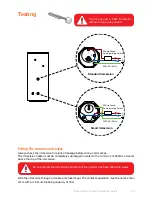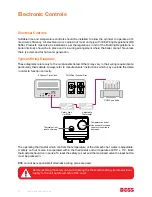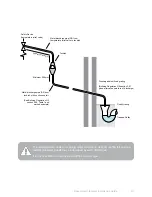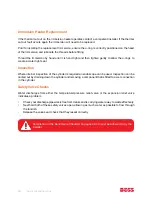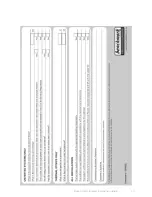
www.bssindustrial.co.uk
36
Examples Of Acceptable Dischargement Arrangements
Ideally below the fixed grating and above the water seal in a trapped gulley.
Downward discharges at a low level; i.e. up to 100mm above external surfaces such as car parks,
hard standings, grassed areas etc. are acceptable providing that where children play or otherwise
come into contact with discharges, a wire cage or similar guard is positioned to prevent contact
whilst maintaining visibility.
Discharges at a high level; e.g. in to metal hopper and metal down pipe with the end of the discharge
pipe clearly visible (tundish visible or not) or onto a roof capable of withstanding high temperature
discharges of water and 3m from any plastic guttering systems that would collect such discharges
(tundish available).
Where a single pipe serves a number of discharges, such as in blocks of flats, the number served should
be limited to not more than 6 systems so that any installation can be traced reasonably easily.
The single common discharge pipe should be at least one pipe size larger than the largest individual
discharge pipe to be connected. If unvented hot water storage systems are installed where discharges
from safety devices may not be apparent, i.e. in dwellings occupied by blind, infirm or disabled
people, consideration should be given to the installation of an electronically operated device to warn
when discharge takes place.
Worked Example
The example on the next page is for G1/2 temperature relief valve with a discharge pipe (D2) having
4 No. elbows and length of 7m from the tundish to the point of discharge.
Maximum resistance allowed for a straight length of 22mm copper discharge pipe (D2) from a G1/2
temperature relief valve is: 9.0m. Subtract the resistance for 4 No. 22mm elbows at 0.8m each =
3.2m. Therefore the maximum permitted length equates to: 5.8m. 5.8m is less than the actual length
of 7m, therefore calculate the next largest size.
Maximum resistance allowed for a straight length of 28mm pipe (D2) from a G1/2 temperature relief
valve equates to: 14m. As the actual length is 7m, a 28mm (D2) copper pipe will be satisfactory.
G 1/2
G 3/4
G1
Min. size of discharge pipe D1
15mm
22mm
28mm
Min. size of discharge pipework
D2 from tundish
22mm 28mm 35mm 28mm 35mm 42mm 35mm 42mm 54mm
Max. length of straight pipe (no
bends or elbows)
Up to
9m
Up to
18m
Up to
27m
Up to
9m
Up to
18m
Up to
27m
Up to
9m
Up to
18m
Up to
27m
Deduct the gure below from the
maximum length for each bend
or elbow in the discharge pipe
0.8m 1.0m 1.4m 1.0m 1.4m 1.7m 1.4m 1.7m 2.3m
Sizing of copper discharge pipe (D2) for a temp. relief valve with a G1/2 outlet size (as supplied)
Discharge Arrangement
Summary of Contents for BOSS 100
Page 4: ...www bssindustrial co uk 4 ...
Page 31: ...Boss Direct Indirect Installation Guide 31 Cylinder Schematic Electrical Diagram S Plan ...
Page 33: ...Boss Direct Indirect Installation Guide 33 Cylinder Schematic Electrical Diagram Y Plan ...
Page 44: ...www bssindustrial co uk 44 48 Direct Indirect Mains Pressure Benchmark Checklist ...
Page 45: ...Boss Direct Indirect Installation Guide 45 49 Water Storage System Commisioning ...
Page 47: ...Boss Direct Indirect Installation Guide 47 Notes ...




